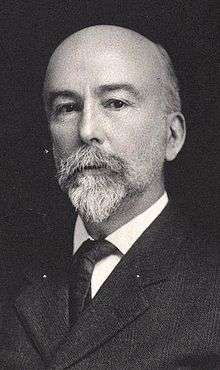Cycle of erosion
The geographic cycle or cycle of erosion is an idealized model that explains the development of relief in landscapes.[1] The model starts with the erosion that follows uplift of land above a base level and ends eventually in the formation of a peneplain.[1] Landscapes that bear evidence of more than one cycle of erosion are termed "polycyclical".[1] The cycle of erosion and some of its associated concepts have, despite popularity, been subject of much criticism.
The model
William Morris Davis, the originator of the model, divided it into stages whose transition is gradual. The model begins with an uplifted or to-be-uplifted landscape. Then Davis defined a youthfull stage where river incision is the dominant process shaping the landscape. During the youthfull stage height differences between uplands and valley bottoms increases rapidly. The youthfull stage is followed by a mature stage where height differences between valley bottoms and uplands is as greatest. Beginning in the mature stage slope decrease becomes a more important phenomenon and uplands loses height more rapidly than rives incise, effectively diminishing relief. In the very latest stage erosion has acted by such long time that the landscape –despite original height– is reduced into a rolling lowland. This landscape of low relief is called a peneplain and may contain residual heights standing out from the general level. The peneplain can be uplifted starting a second erosion cycle.[2]
The model assumes rapid and episodic tectonic uplift and that slopes evolve by decline, meaning that initially steep slopes are worn out by erosion forming successively gentler slopes.[3] Weaknesses of the model are that it is mostly theoretical and deductive in nature, further it does not take into account the complexity of tectonic movements or climate change. The nature of surface processes is also poorly represented by the model.[3] The model in its original form is intended to explain relief development in temperate landscapes where erosion by running water is assumed to be of prime importance.[2][3] Nevertheless the cycle of erosion has been extended, with modifications, into arid, glacial, coastal, karst and periglacial areas.[3]
| Environment | Proposed by | Details |
|---|---|---|
| Arid | Davis, 1905 | At the beginning of the cycle of erosion in arid climate there are numerous small basins to where material is washed during the scarce rainfall events. The in the next stage (youthful stage) valleys are developed and highlands dissected by these. Gentle slopes and basins accumulated material derived from the highlands. In the mature stage drainage basins coalesce. At the end a stage is reached where the terrain has lost much of its relief and deflation hollows interfere with the drainage systems, breaking it up to local systems. During all stages sand and dust might be exported by wind to other landscapes.[4] |
| Coastal | Johnson, 1919 | At the beginning of a cycle of erosion submerged coasts have usually steep slopes entering the sea. At a youthfull stage wave erosion and other agents have have transformed the slope into a cliff with a wave-cut platform at its base. The eroded material either adds to a nearby submarine talus slope or is transported further offshore. As the platform grows waves loses more energy traversing it and become thus less effective in erosding the cliff. By the same time the cliff has grown in height and it becomes increasingly difficult for the waves to evacuate debris from the base of the cliff. At a mature stage cliff erosion is at equilibrium with the removal of debris by the waves and beaches may form. Continuing into an old stage the cliff becomes less steep slope At a very old age the cliff becomes low and flattish and disappear from the simple view.[5] |
| Glacial | Davis, 1900 | |
| Karst | Cvijić, 1918 | |
| Periglacial | Peltier, 1950 | The periglacial cycle of erosion begins with a non-periglaciated landscape. Once periglaciated mass wasting of regolith exposes bedrock in the upper slopes. These outcrops are then subject to frost weathering that make slopes retreat forming extensive blockfields at the base of the bedrock areas. At a later stage solifluction wears down summits and fills in topographic lows.[6] |
History

Early acclaim and criticism
After the model was first developed by William Morris Davis around 1900 it received wide acclaim, but was never universally accepted.[1][3] The initial enthusiasm and strength of the cycle of erosion model has been attributed to various causes. First, the model provided a framework to study areas and epochs in Earth history where erosion is the dominant process. Second, the model fitted well into the grand evolutionary thought that had emerged in the 19th century with Darwin's evolution theory. Lastly, some popularity was indebted to Davi's lucid writing style. The model achieved its greatest popularity in the 1900–39 period when numerous studies on denudation chronology based on the model were published. In these studies usually two to five erosion cycles were identified. The approach of doing denudation chronology with the cycle of erosion model lost popularity from the 1930s onward. Arguably this was so because the approach did not provide any unforeseeable insights. An increasing number of geomorphologists had begun to study processes happening in the present and not in the past as done with the cycle of erosion model. These process geomorphologists soon realized some of their observations were at odds with Davi's model. Other geomorphologists turned away from the cycle of erosion to work instead on climatic or tectonic geomorphology.[7]
While the model was at first widely accepted among Anglo-Saxon scholars,[3] in Continental Europe it met some resistance with German scholars Albrecht and Walther Penck, Siegfried Passarge and Alfred Hettner standing out as early opponents to the model.[8] Walther Penck and Lester Charles King proposed alternative cycle theories in the 1920s and 1960s respectively.[1]
Intensified criticism (1960s)

While King's ideas were an attempt at refuting Davi's cycle of erosion they were themselves of cyclical nature and contributed to usher a wave of criticism in 1960s against both his and Davi's models.[3][10] This criticism has been referred to as called "Davis bashing" by Cliff Ollier and constitute to Ollier the ridicule of cyclical theories in geomorphology without any alternative model being proposed.[10]
The notions of time, uplift, slope and drainage density evolution in the erosion cycle have been criticized.[7] Further the validity of some whole concepts associated with the cycle of erosion have been questioned including stream grade, base level and most of all that of peneplains.[7]
Writing in 1971 geomorphologist Ronald Flemal summarized the situation as follows:[7]
- Currently geomorphologists are divided into three camps: those who still adhere to Davisian concepts, either in the original or a modified form; those who desire to replace Davisian ideas by a different cyclic erosional model; and those who reject cyclic erosion completely.
Modern status
Despite considerable criticism the cycle of erosion model has remained part of the science of geomorphology.[11] The model or theory has never been proved wrong,[11] but neither has it been proven.[12] The inherent difficulties of the model has instead made geomorphological research to advance along other lines.[11] In contrast, the cycle of erosion model is a common approach used to establish denudation chronologies, and is thus an important concept in historical geology.[13] While acknowledging its shortcomings modern geomorphologists Andrew Goudie and Karna Lidmar-Bergström have praised it for its elegancy and pedagogical value respectively.[3][1]
See also
Footnotes
- 1 2 3 4 5 6 Lidmar-Bergström, Karna. "erosionscykel". Nationalencyklopedin (in Swedish). Cydonia Development. Retrieved June 22, 2016.
- 1 2 Davis, William M. (1899). "The Geographical Cycle". The Geographical Journal. 14 (5): 481–504.
- 1 2 3 4 5 6 7 8 9 Goudie, A.S. (2004). "Cycle of erosion". In Goudie, A.S. Encyclopedia of Geomorphology. pp. 223–224.
- ↑ Davis, W.M. (1905). "The Geographical Cycle in an Arid Climate". The Journal of Geology. 13 (5): 381–407.
- ↑ Johnson, 199–228
- ↑ French, Hugh M. (2007). The Periglacial Environment (3th ed.). John Wiley & Sons Ltd. pp. 245–246. ISBN 978-0-470-86588-0.
- 1 2 3 4 Flemal, Ronald C. (1971). "The Attack on the Davisian System Of Geomorphology: A Synopsis": 3–13.
- ↑ Chorley et al. 2005, p. 572
- ↑ Ollier, Cliff (2014). "Some Principles in the Study of Plantion Surfaces". In Rabassa, Jorge; Ollier, Cliff. Gondwana Landscapes in southern South America. Springer. pp. 47–48.
- 1 2 Ollier, Cliff (1995). "Classics in physical geography revisited". Progress in Physical Geography. 19 (3): 371–377.
- 1 2 3 Slaymaker, Olav (2004). "Geomorphic evolution". In Goudie, A.S. Encyclopedia of Geomorphology. pp. 420–422.
- ↑ Roy, Andre. Contemporary Meanings in Physical Geography: From What to Why?. p. 5.
- ↑ Jones, David K.C. (2004). "Denudation chronology". In Goudie, A.S. Encyclopedia of Geomorphology. pp. 244–248.
Bibliography
- Don J. Easterbrook (1999), Surface Processes and Landforms; second Edition; Chapter Six
- Chorley, Richard J.; Beckinsale, Robert P.; Dunn, Antony J. (2005) [1973]. "Chapter Twenty-Two". The History of the Study of Landforms. Volume Two. Taylor & Francis e-Library.
- Johnson, Douglas Wilson (1919). Shore Processes and Shoreline Development. New York: John Wiley & Sons.
External links
- "Stages in the fluvial cycle of erosion". Illustrations edited by The Association of Polish Geomorphologists. Retrieved January 10, 2016.